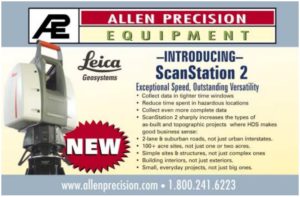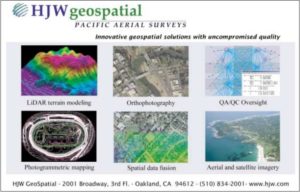
Article by Aaron Smith
Many surveyors have made up their minds that the last thing that they can legally do without overlap from other professions is to survey a deed described line, make a determination as to its location and file his or her opinion (map). I may or may not agree with this, but what I am referring to is commonly known as the “Record of Survey”, and for most Professional Land Surveyors, they consider it their document. During this discussion on the Record of Survey, which is reviewed by the County Surveyor’s Office and subsequently recorded in the County Recorder’s Office, I will pose the question; whose map is it? Is it a map that is prepared by you and should be recorded as is, or does it have the look and feel of your county surveyors opinion, or do you take into account the future and put together a document that will stand the test of time? I hope that the map will be a compilation of all three. I will take the position that it is the public’s map and it is my privilege to survey the lines, set the corners, and file it with the County. On March 16, 1907, the Senate enacted what would be commonly known as the Land Surveyors Act, and most, if not all of those statutes are still with us in the now current Professional Land Surveyors Act (Business and Professions Code, B&P).
Even in 1907, the body of the Senate knew the importance of the duties of the Professional Land Surveyor and set guidelines that even today we rely on. Those individuals who had the foresight to enact these statues clearly understood the problems then, and the potential for future problems.
The purpose of the Record of Survey, in my opinion, is to review the written documents that describe land boundaries, locate the deed described lines on the ground, which may need extrinsic evidence to locate, such as parole testimony, note any possible discrepancies that may differ from the written document, and finally, make my findings of Public Record. Principle 5, Chapter 14, The Role of the Surveyor, Brown’s Boundary Control and Legal Principles, fourth edition states “A land surveyor locates boundary lines according to the description in the deed and then relates lines of possession that do not agree with these lines and reports the facts to the client, in writing.” We can also include in this concept, easements or any other written right that can be identified on the ground from the written record. In the Third Edition of Evidence and Procedures for Boundary Location, chapter 5, Evidence-General, it says, “The student, surveyor, or attorney must first make the major distinction between facts and evidence. The actual corner point is a fact, all of the information that is used to identify, describe, recover, or preserve the point is evidence of that point, the corner.” Your map can help perpetuate the evidence that can lead to facts, and the facts can lead to the corner. This map should also locate and show the relationship to any prior surveys, senior lines, or subdivisions that are near or adjoining your property. Your determinations in the location of these lines are a professional opinion, and the evidence used to locate these
boundaries should be reflected on your map. If, during the course of your survey, there is a difference in the location of previously set monuments by other surveyors, and that of the lines you have reconstructed, then it is your duty to show these positions on your map so they may be readily retraced by another surveyor. Your map should clearly show why you have disagreed with these monuments, and if needed, a statement should be made on the map for clarity. This is the essence of Perpetuating the Evidence. Each surveyor over time has been trained as to the different types of evidence used to locate boundaries, such as iron pipes, hubs, fences, old road cuts, historic buildings built at the time of the original subdivision, stones, posts in rock mounds, hedge lines…etc. Perpetuating these types of evidence on the map is of paramount responsibility to the surveyor. The evidence reflected on the map should be noted with the ability to reestablish these occupation lines by mathematical computations, or at minimum, compare the relative positions by scale.
If a Professional Land Surveyor makes measurements to locate the deed described lines, which are different from the apparent lines of occupation, and does not show these on his or her map, then one has not done their job. If there are reasons for these differences, and these reasons are not easily detected in the recorded documents, then notes should be placed on the map for further clarification.
The Record of Survey prepared by you, or under your direction, needs to reflect all the pertinent information and evidence used to establish your boundary decisions, and even that evidence you analyzed, but decided not to rely on.

Chapter 5 of Evidence and Procedures says, “before any surveyor obtains sufficient knowledge of the available evidence, it is nearly impossible to make a correct boundary determination or location.” Unrecorded documents, previous surveys made by your firm, old files from previous land surveyors and or engineers, and any testimony from neighbors or ‘old timers,’ should be noted on your map. The location as to where those documents can be found for inspection by the land surveyor needing to review this information should also be noted in the legend, or notes made on the map. A professional land surveyor should not withhold pertinent information that was used in the final determination of the deed described lines, but should instead look for the opportunity to make that information of public record with the recording of their record of survey. The lack of showing all evidence accepted and not accepted could be the reason there is litigation over your map, or boundary resolution.
“Perhaps the worst disagreements arise from a failure of one surveyor to uncover all available evidence. Two surveyors having the same evidence, if equally educated and equally intelligent, should come to the same conclusions. Unfortunately, all surveyors are not equally diligent in their search. The one with all the evidence usually comes to the correct conclusion, whereas the one with partial evidence
makes faulty locations.” This is a quote from Chapter 5, Evidence and Procedures, and is for both field evidence and research. I hope that surveyors will take the time to uncover the evidence, document that evidence on their map, and perpetuate it for the next land surveyor, so we can have “all the evidence” available to the profession.
“A plat should be complete in itself and should present sufficient evidence of monuments (record and locative) and measurements so that any other surveyor can clearly, without ambiguity, find the locative points and follow the reasonings of the surveyor. A plat does not show the client’s land alone; it shows all ties necessary to prove the correctness of location.”, Chapter 9, Evidence and Procedures.
The map should reflect the measured bearings and distances, B&P code 8764, and compare those to the record information. The record information for comparison could be deeds, maps, unrecorded surveys, unrecorded grants, County right of way maps, survey notes from the County Surveyor’s Office, and any other document you have obtained. If these documents are not recorded in the Recorder’s Office, they should be referenced on your map. For all the monuments found, there should be a complete description of the monument,
including any scribings, character, type of metal, size, and its relative position to occupation, fence corners…etc. If you are noting a fence, then the type and material should be noted as well. This will assist the land surveyor to identify these lines of occupation for future retracements. “If the surveyor is delegated the privilege of remonumentation of deteriorated corners, he should also be delegated the responsibility of perpetuating the evidence.” Quote from Chapter 15, Evidence and Procedures.
Now that we have discussed some of the reasoning’s behind the record of survey, let’s look at the question posed, whose map is it? As I stated early on, I believe it is the public’s map, and I have been hired to prepare this document and have it recorded with the county in which the survey was made. These maps perpetuate the location of old historic pieces of evidence, and when we can continue to use these maps to relocate these positions, then it is in the interest of the public to have the map properly documented. Land surveyors in the past and the present have felt that the map they were hired to prepare, is the record of their professional opinion and final conclusions as to the retracement of the deed described lines, and the map should be recorded as they see fit. Without a doubt that is true, the map reflects their decisions, and it should, this is the reason we sought licensure, so we can take responsibility for those decisions. If one does a proper survey and documents the map correctly, then there will be no need for comment on the record of survey before filing, which is, in my opinion, the goal that should be strived for with your survey. There is a list of items that the County Surveyor is required to review for technical correctness before they approve the map for recording, and they are listed in section 8764 of the Professional Land Surveyor’s Act:
- All monuments found, set, reset, replaced, or removed, describing their kind, size, and location, and giving other data relating thereto.
- Bearing or witness monuments, basis of bearings, bearing and length of lines, scale of map, and north arrow.
- Name and legal designation of the property in which the survey is located, and the date or time period of he survey.
- The relationship to those portions of adjacent tracts, streets, or senior conveyances which have common lines with the survey.
- Memorandum of oaths
- Statements required by section 8764.5
- Any other data necessary for the intelligent interpretation of the various items and locations of the points, lines, and areas shown, or convenient for the identification of the survey or surveyor, as may be determined by the civil engineer or land surveyor preparing the record of survey.
The record of survey shall also show, either graphically or by note, the reason or reasons, if any, why the mandatory filing provisions of paragraphs (1) to (5), inclusive, of subdivision (b) of Section 8762 apply.
The record of survey need not consist of a survey of an entire property.
As you can see, there is not much that can be reviewed to check for consistency with this section. However, one should note subsection (g) which states “any other data necessary for the intelligent interpretation of the various items,” again telling the surveyor in responsible charge to ensure that the map and its evidence as shown is in harmony with the results of the evidence on the ground. Remember, the county surveyor reviews your map based upon the information provided by the professional, and hardly ever does the county surveyor visit the subject property to inspect the results of your survey. If the record of survey is properly documented, then the evidence used in today’s boundary determination will be made of record for all of time, and the welfare of the public as it relates to land boundaries are better served.
There is one other section that allows for further review by the county surveyor and that is section 8766 (c) which in part states, “nothing in this section shall limit the county surveyor from including notes expressing opinions regarding the record of survey, or the methods or procedures utilized or employed in the performance of the survey.” When applicable, it is appropriate for the county surveyor to request additional information to substantiate the conclusion of the field survey performed, and I believe this section allows for the county surveyor to ask for this. And of course, we are all familiar with section 8768, which in short says the county surveyor and the surveyor preparing the map may add notes to the items not agreed upon in accordance with section 8766, and these notes are added to the map prior to recording.
I have taken the position with my maps that the agency reviewing my survey map before it records is the last set of eyes to check my work and provide me with feedback. I would rather have a comment on the review of my map, than for the map to record for all of time with my errors. I may not always agree with the comments, but rarely do I find a need to argue with them either.

One of our jobs as a professional surveyor in the state of California is to render a professional opinion on the location of a deed described line. Yes, there are those who believe we are licensed to monument and locate the unwritten transfer of title, better known as Adverse Possession or Prescriptive Rights, but I still believe we should locate deed described lines and show the relationship of occupied land that is not consistent with the deed, and let the judicial system transfer unwritten rights when necessary. This can be a complicated area of surveying, and I will not render any opinions on how you or your firm should handle these situations. When there is a discrepancy between the deed described lines and the lines of apparent occupation, I believe the land surveyor has a duty to both parties to find solutions. It is unfair to the property owners, to set your corners, note the discrepancies on the map, and record it without the involvement of the neighbors. Yes, I do think Land Surveyors should play an active role in the solution, but they must also understand the laws, and which remedies are applicable to their situation. You do not want to make the situation worse by applying an incorrect solution to the already existing controversy between neighbors.
When we, as Professional Land Surveyors, perform a survey and document it to perpetuate all the possible evidence, it is then, that the public’s best interest is protected, and the land surveyor has done their job, and so, the question, ‘whose map is it?.’
Something I feel all land surveyors should remember; the budget should never compromise the integrity of the survey work. We have been hired to perform a function, and an important one at that, one that affects not only your client,
who is paying the bill, but all of the adjoining lines you are surveying. Consider the impacts of reestablishing a section corner, the impact of that decision could affect property rights in four different sections, 2 miles by 2 miles. More importantly, most, if not all of the property owners who are affected by the field survey and establishment of the section corner, had no input to your roles and responsibilities, but the survey is now of record.
We are charged with being a Professional, so one should not step lightly into this line of work, unless they are prepared. For those surveyors who have been around awhile, they should look to pass on as much knowledge and skill as possible to those who will follow. One of the ways to perpetuate evidence, is to teach and mentor those individuals coming up through the profession, so they may learn the proper techniques and skills to allow them to be a Professional, and protect the welfare of the public as you have.
This article is not a guide to performing boundary surveys and preparing Records of Surveys, but merely a reminder to remember what your job as Professional Land Surveyor is, and a very important one, at that.
I would like to thank Paul M. Brown, PLS and Lawrence A. Stevens, PLS for their mentoring efforts.